How to grow Cyperus
Also known as umbrella grass, papyrus, nutsedge, and galingale, cyperus is a large genus of water-loving evergreen sedges, mainly from tropical and subtropical areas. The many hundreds of species vary greatly in size, though are recognisable for the starburst-like flower spikelets held at the top of their stems, with umbrella-like strappy bracts underneath.
Two of the most popular species are Cyperus alternifolius and C. papyrus, grown widely throughout the world as pond marginals or houseplants. Their tender nature means that in the UK they are best grown either permanently indoors, or in containers to allow for overwintering inside. C. longus is a lesser known, hardy species native to southern parts of the UK. Though not quite as striking as its famous counterparts, it makes a tough, fuss-free, wildlife-friendly addition to pond margins.
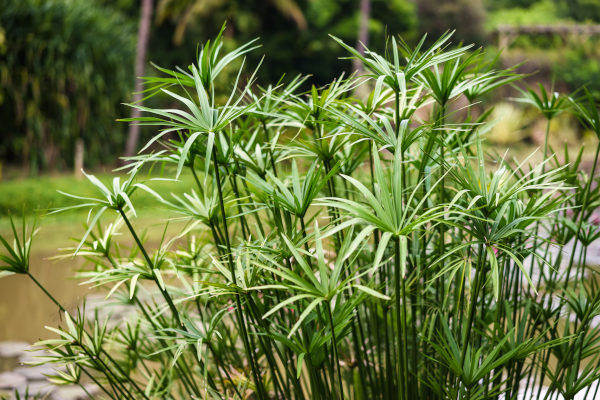
Zantedeschia is a genus of flowering plants from the family Araceae and is native to southern Africa. With a rich history dating back to the Ancient Romans, these deciduous or semi-evergreen perennials have been used as a symbol of celebration. Zantedeschia was Named after Professor Giovanni Zantedeschia, an Italian botanist.
There are two main forms of Zantedeschia: hardy and tender. Hardy forms of the plant can be grown outdoors, enjoy moist soil and full sun or partially shaded conditions - these are known as Arum lilies. Tender forms of Zantedeschia prefer being grown in containers or pots and should be brought inside over the winter - these are known as Calla lilies.
With tuberous flora in all colours from whites, yellows and oranges to deep reds and purples, Zantedeschias are not to be overlooked in any garden, as long as they have sufficient sunlight to grow in.
Ready to learn more about growing Zantedeschia? Read on for all there is to know...

Key Information
Soil pH
Position
Hardiness

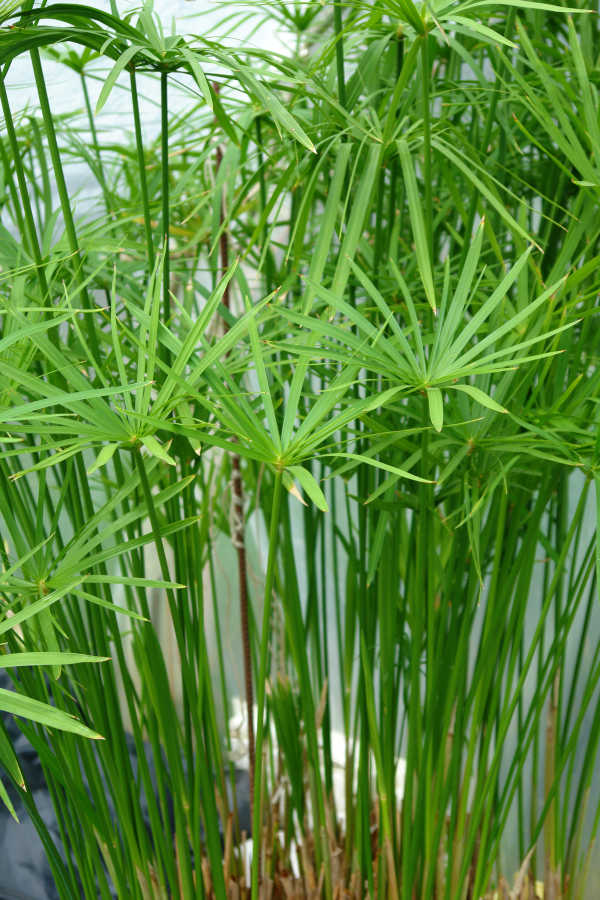
Where & when to plant Cyperus
Position - Outside: sun or partial shade Indoors: bright, indirect light
Soil - Loamy soil or compost
Flowering Period - Summer to autumn
Hardiness - Varies depending on species.
C. alternifolius is tender, rated H2 which means a minimum temperature of 1 to 5°C.
C. papyrus is subtropical, rated H1B meaning a minimum temperature of 10 to 15°C
C. longus is hardy, rated H6, with a minimum temperature of -15 to -20°C.
Cyperus species vary in their tolerance of the UK climate, making it important to familiarise yourself with the requirements of your plant before deciding where to put it, and when.
Subtropical species such as C. papyrus will only cope outside during the warm summer months and are best kept as houseplants the rest of the time.
Tender species like C. alternifolius can live outside in the UK once all risk of frost has passed, which varies from region to region though tends to be mid to late May. If they arrive before it is safe to put them outside, keep them in a bright, frost-free ‘holding zone’ such as a greenhouse, conservatory, coldframe, or sunny porch or windowsill, remembering to keep them well-watered during this time.
Hardy species such as C. longus can spend all year round outdoors and are best planted in spring.
In terms of location, cyperus grown indoors enjoys a spot in bright, indirect light. While this may sound counterintuitive, it simply means not in the direct glare of the hottest midday summer sun, and can be achieved by setting the plant back slightly from a south facing window, putting it on an east or west facing windowsill, or in a sunny spot with some form of light shading (net curtain, adjustable blind etc.). Perhaps even more importantly, cyperus needs consistent moisture – best achieved by standing the container in a shallow tray of water.
Outdoors, grow cyperus in the margins of a pond or in a bog garden. Tender and subtropical species will need to be moved indoors for winter, so are best grown in a container or aquatic basket.
A note on hardening off
Subtropical or tender plants need to be gradually hardened off before making the move from indoors to out. This slow ‘toughening up’ reduces the chances of shock, which can severely check growth.
The easiest way to do this is by using a coldframe opened in gradual increments over the course of a week or two. Keep the lid closed at night until the last couple of days of the hardening off period.
If you don’t have a coldframe, a bit of horticultural fleece combined with a spot of ‘musical pots’ works just as well. A couple of weeks before you anticipate planting your cyperus out, wrap it in a couple of layers of fleece and place outside during the day (moving back into a warm, protected environment at night). Do this for a few days then reduce the fleece to one layer. After a few more days like this, remove the fleece completely. If it’s warm enough you can leave outside at night too, though reapply the fleece for this. Towards the end of the hardening off period, leave outside completely uncovered for a couple of days and nights before planting out as below.
How to plant Cyperus
- To grow as a houseplant, first choose an appropriately sized pot. The best practice is to go for one just a few centimetres larger than the current rootball, gradually increasing every few years. Ensure there are plenty of drainage holes in the bottom.
- Using a loam-based potting compost, start by partially filling the pot – enough so that when placed on it the upper surface of the root ball is about 3cm lower than the top of the pot.
- Fill around the plant with compost, firming down with your fingers then adding a little more so it is held tight.
- Pick up the container and lightly tap on the potting bench or ground a few times to help further settle the compost around the plant.
- Soak well with water.
- A mulch with horticultural grit will look attractive and help to prevent a ‘cap’ or crust forming on the top of the compost (something container plants can suffer due to the artificial nature of their watering).
- Stand in a saucer or shallow tray of water.
- To plant into pond margins using an aquatic basket, unless this has very fine mesh, line with hessian or polypropylene fabric to prevent the compost from washing out. Alternatively, a hessian bag makes a plastic-free alternative to a planting basket.
- Part fill with a specialist aquatic compost. Resist the temptation to use normal potting compost, as this contains fertilisers which will leach out into the water and harm the aquatic ecosystem.
- Position the cyperus in the basket or bag so it sits at the same depth as in the original container.
- Infill around it with more aquatic compost, firming in as you go.
- Mulch with grit or fine gravel to prevent the surface of the compost becoming stirred up into the water.
- Submerge into the water, aiming for the gravel surface to sit 3-5cm below water level. You may need to weigh it down with rocks until the compost becomes fully saturated, after which it should remain in place.
- To grow in the ground (hardy species only) in a boggy area or reliably moist soil, first clear the area of weeds.
- Dig a planting hole several times larger than the root ball.
- Place the plant in the hole, ensuring the top of the root ball sits level with the surface of the soil.
- Backfill with soil and firm in gently.
- Soak with water (not necessary in a bog garden!).
- Mulch with well-rotted organic matter.
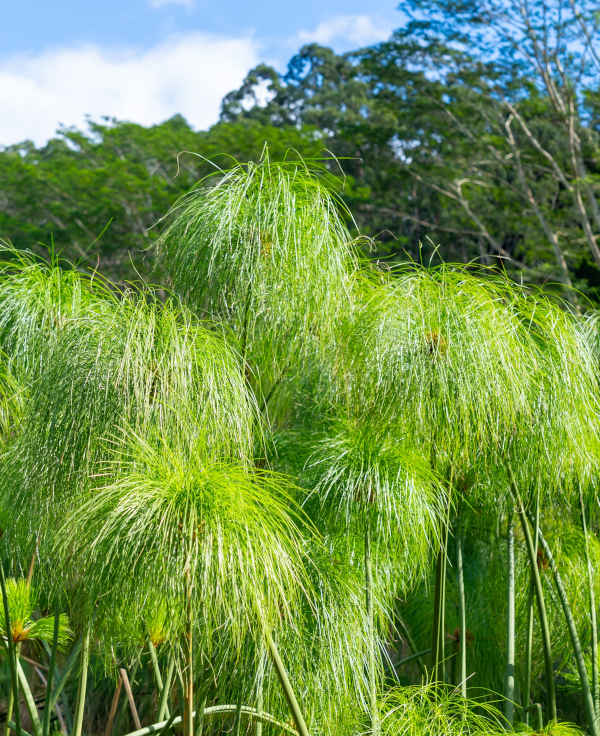
What to plant with Cyperus
To use as part of a pond or bog planting scheme, combine cyperus with companions such as Baldellia ranunculoides, Butomus umbellatus, Persicaria amphibia, Veronica beccabunga, or Ranunculus acris Multiplex. Alternatively, check out our aquatic collections for ready-to-go combinations.
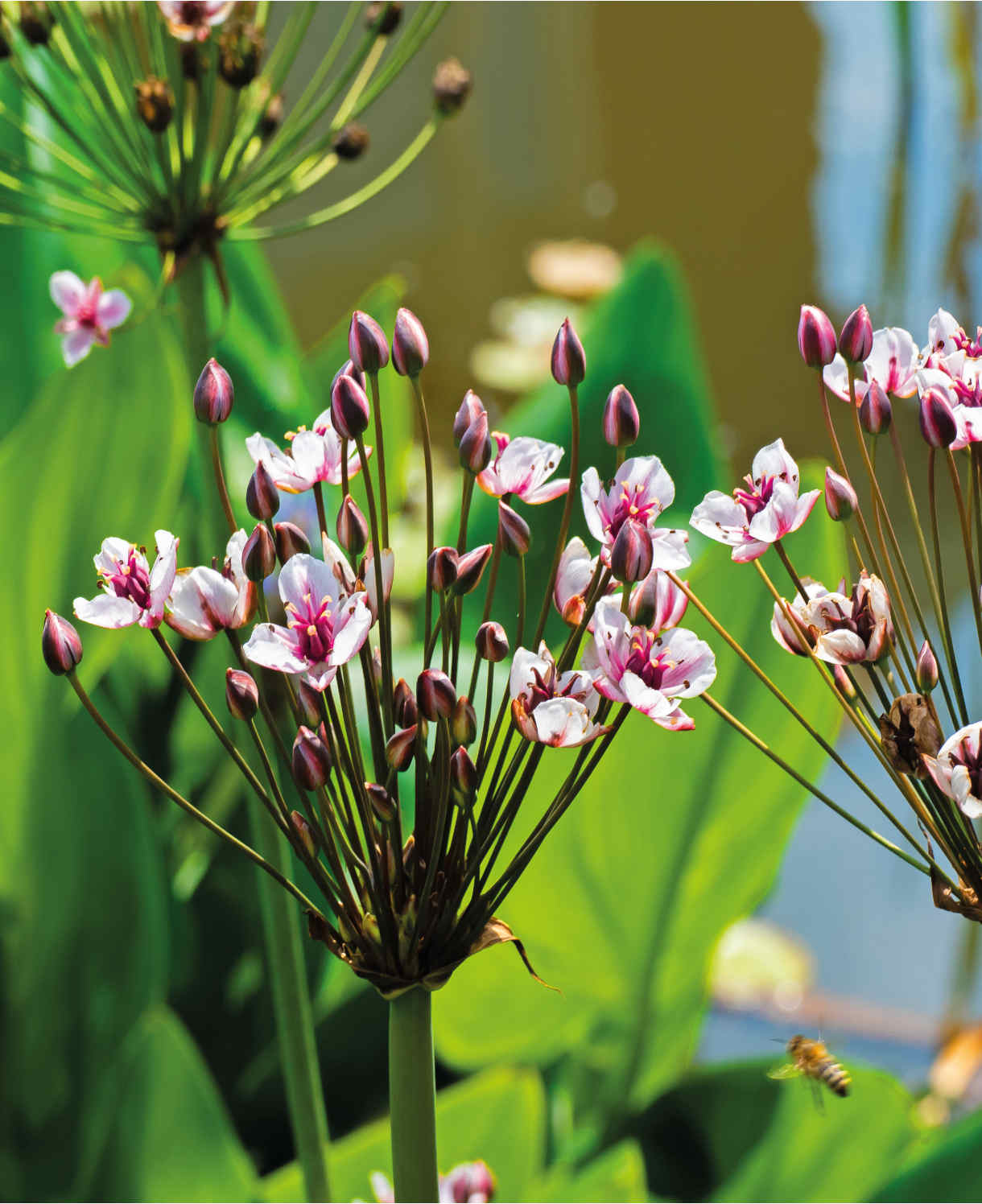
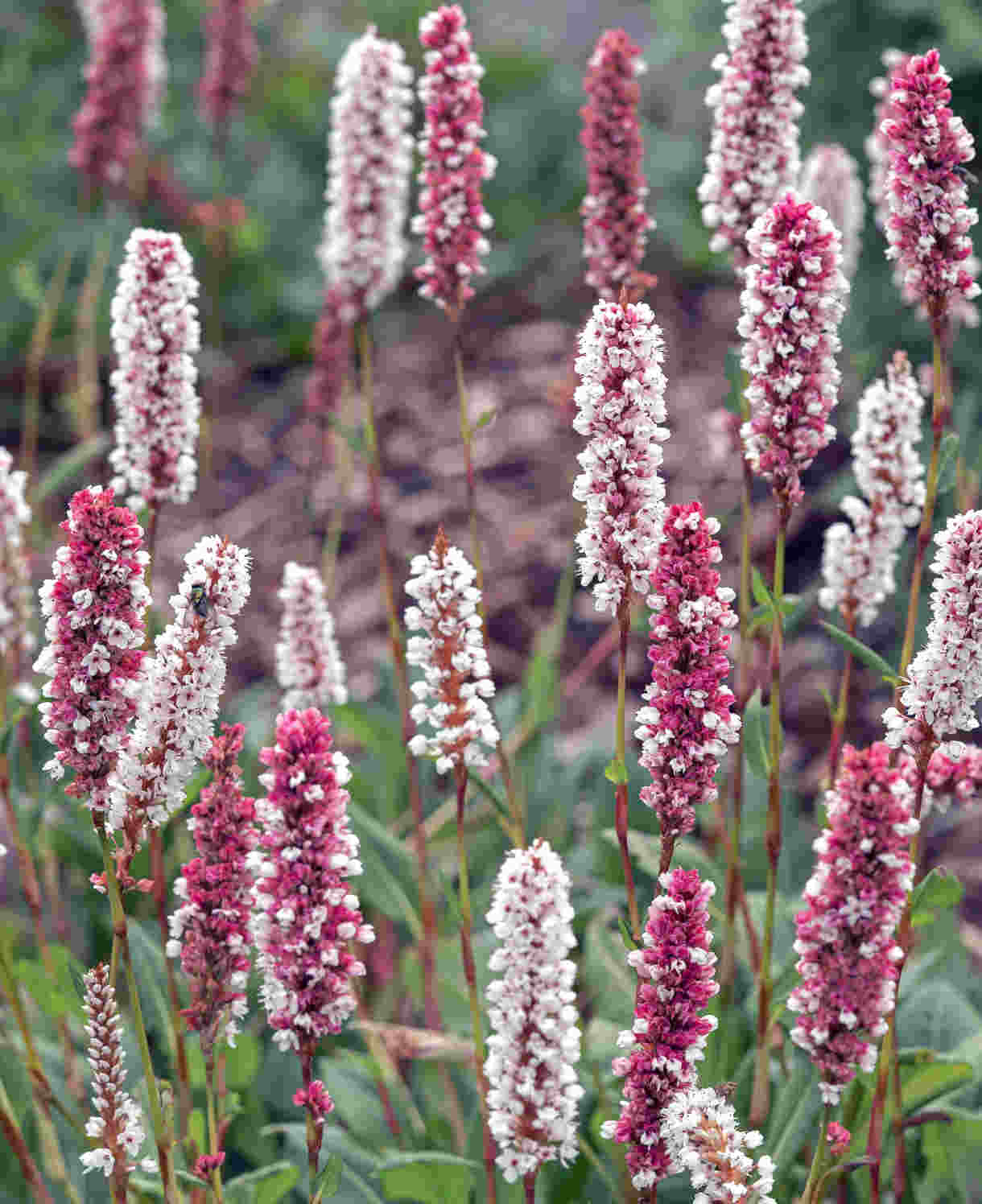

How to care for Cyperus
Pruning and Deadheading
Cyperus is evergreen so doesn’t require a whole plant chop back, though will benefit from an autumn tidy. Cut out old or browning foliage just above the base.
You may also see the roots of cyperus rising out of containers. These can be trimmed back regularly without any ill effects.
Watering
We hardly ever say this about a plant, but it’s difficult to overwater cyperus. When grown indoors it’s a good idea to have the pot sitting in a saucer or shallow tray filled with water, changing this every so often to prevent issues such as insect larvae. Water freely throughout the growing season then scale back during the cooler months, watering just enough to prevent the compost drying out.
Outdoors, keep an eye on the water level of ponds and bog gardens, topping up when necessary (preferably with harvested rainwater).
Those planted in damp borders should also be monitored and watered during hot, dry spells to maintain consistently damp conditions.
Feeding
Container-grown cyperus benefits from a monthly application of balanced liquid feed throughout the growing season. It is also a good idea to repot into fresh compost every year or two, as standing in water speeds up the rate at which compost degrades and therefore affects the vigour of the plant.
Cyperus grown in a pond or bog garden does not require feeding due to the high nutrient content of the water, and in fact adding fertiliser to this environment can cause more harm than good.
Cold Protection
With the exception of hardy native species C. longus, cyperus will need indoor protection over winter.
Start thinking about bringing it inside in September. Subtropical species such as C. papyrus are the first to come in and are best kept somewhere warm such as a heated conservatory or windowsill where temperatures remain above 15°C. Tender species such as C. alternifolius can tolerate it a little cooler – an unheated but sunny conservatory is ideal, or anywhere that doesn’t drop below 10°C-ish.
A bucket, bowl, or tub partially filled with water make a good indoor substitute for pond margins when overwintering aquatic baskets or bags.
Pests and Diseases
Outdoors, cyperus is considered trouble-free, though when grown inside it can become host to spider mites. Keeping indoor plants as healthy as possible is the key to warding off problems, and by this we mean proper ventilation, adequately spaced plants (for good air flow), making sure everything is well-watered and fed, and repotted into larger containers when necessary. Thoroughly cleaning the indoor environment every winter can also help to remove overwintering pest populations.
Where infestations do take hold, try introducing biological controls (often sachets or tubes containing miniscule natural predators), or in the worst cases, remove the affected plant/s altogether.
How to propagate Cyperus
- alternifolius has one of the niftiest methods of propagation we know of. Simply cut a stem and place it upside down in water, where small plantlets will develop from the submerged inflorescence. These can then be separated and potted on individually. The approach may seem bizarre but is in fact a recreation of how the plant naturally reproduces when its stems flop over into the water.
Other species are best either propagated by seed or divided, both of which are best done in spring. The seed of subtropical and tender species should be sown at 18-21°C on permanently moist compost, while hardy species can be sown in a container in a coldframe.
To divide cyperus, simply tease apart an existing clump into smaller pieces and repot. Use a serrated knife on any congested clumps that can’t be pulled apart by hand. As well as providing new plants, this is a recommended practice every few years to ease overcrowding in the container and ensure continued healthy growth.
* Many plants carry Plant Breeders Rights and cannot be propagated for commercial purposes.
Common Cyperus questions
Is cyperus easy to grow?
As long as you don’t allow it to dry out or become too cold, cyperus is straightforward and a popular ornamental throughout the world.
Is cyperus invasive?
In frost free climates, some species of this rhizomatous, spreading plant are highly invasive. Fortunately, our cold winters keep them in check. The UK native species longus is less rampant, though still best grown in a container or basket to prevent unwanted spread.





